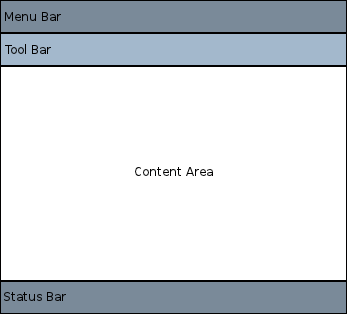QML 文档采用高度可读、结构化布局定义对象层次结构。每个 QML 文档由 2 个部分组成:导入章节和对象声明章节。用户界面的最常见类型和功能的提供在
QtQuick
导入。
要使用 Qt Quick 模块,QML 文档需要导入它。import 句法看起来像这样:
import QtQuick
类型和功能的 Qt Quick 提供现在可用于 QML 文档!
QML 文档中的对象声明定义将在视觉场景中显示什么。 Qt Quick 提供用于所有用户界面的基本构建块 (譬如:用于显示图像、文本及用于处理用户输入的对象)。
简单对象声明可能是带有一些居中文本的彩色矩形:
Rectangle { width: 200 height: 100 color: "red" Text { anchors.centerIn: parent text: "Hello, World!" } }
这定义对象层次结构采用根
Rectangle
对象,其拥有子级
Text
对象。
parent
的
Text
对象被自动设置到
Rectangle
,和同样,
Text
对象被添加到
children
特性为
Rectangle
对象,通过 QML。
The
Rectangle
and
Text
类型用于以上范例, 两者的提供通过
QtQuick
导入。将 import 和对象声明放在一起,得到完整 QML 文档:
import QtQuick Rectangle { width: 200 height: 100 color: "red" Text { anchors.centerIn: parent text: "Hello, World!" } }
若将该文档另存为 HelloWorld.qml,可以加载并显示它。
要显示由 QML 文档定义的图形场景,可能加载它采有 Qt Creator 。对于如这种的简单 UI 文件,选择 File > New File or Project > Application (Qt Quick) > Qt Quick Application - Empty 从 Qt Creator 中。
按绿色 运行 按钮运行应用程序。应该见到文本 Hello, World! 在红色矩形中心。
有关在 Qt Creator 中创建和运行工程的更多信息,拜访以下页面:
虽然 Qt Quick 提供基本图形元素, Qt Quick Controls 提供现成的 QML 类型以供在应用程序中使用。
插入 ApplicationWindow 类型是创建应用程序的很好起点。应用程序 UI 拥有这种基本布局:

在各区域内,不同 controls 可以添加并连接以形成应用程序。例如,以下代码片段是演示可用空间用法的基本应用程序:
//import related modules import QtQuick import QtQuick.Controls //window containing the application ApplicationWindow { visible: true //title of the application title: qsTr("Hello World") width: 640 height: 480 //menu containing two menu items menuBar: MenuBar { Menu { title: qsTr("File") MenuItem { text: qsTr("&Open") onTriggered: console.log("Open action triggered"); } MenuItem { text: qsTr("Exit") onTriggered: Qt.quit(); } } } //Content Area //a button in the middle of the content area Button { text: qsTr("Hello World") anchors.horizontalCenter: parent.horizontalCenter anchors.verticalCenter: parent.verticalCenter } }
应用程序拥有 2 菜单项和中间按钮。点击 Exit 菜单项关闭应用程序。
还有不同导航方法和不同控件 (譬如:按钮和滑块)。以下范例是可用的从 Qt Creator 并演示不同控件及布局。
Feel free to copy and paste the snippets onto this simple Hello World application to see how QML works.
使用 QML 定义用户界面的一大优势是它允许用户界面设计者定义应用程序应如何采用简单 JavaScript 表达式对事件做出反应。在 QML 中,我们引用这些事件作为 signals 和这些信号被处理通过 信号处理程序 .
例如,考虑以下范例:
import QtQuick Rectangle { width: 200 height: 100 color: "red" Text { anchors.centerIn: parent text: "Hello, World!" } TapHandler { onTapped: parent.color = "blue" } }
This example can be saved as "ClickableHelloWorld.qml" and run with
qml
,
QML Runtime Tool
. Whenever the user clicks anywhere in the window, the rectangle will change from red to blue.
注意: TapHandler 还为触摸事件发射敲击信号,因此此代码也工作于移动设备。
可以采用简单表达式处理类似键盘用户输入:
Rectangle { width: 200 height: 100 color: "red" Text { anchors.centerIn: parent text: "Hello, World!" } focus: true Keys.onPressed: { if (event.key == Qt.Key_Return) { color = "blue"; event.accepted = true; } } }
通过接受聚焦,颜色可以改为蓝色,每当按下返回键时。
对象及其特性形成 QML 文档定义的图形界面基础。QML 语言允许特性以各种方式相互绑定,使用户界面能够高动态。
在以下范例中,几何体对于每个子级 Rectangle 被绑定到父级 Rectangle 。若几何体对于父级 Rectangle 被改变,几何体对于每个子级 Rectangle 将自动更新由于特性绑定。
Rectangle { width: 400 height: 200 Rectangle { width: parent.width / 2 height: parent.height color: "blue" } Rectangle { width: parent.width / 2 height: parent.height x: parent.width / 2 color: "green" } }
特性还可以动态更新凭借动画。
QtQuick
import 提供各种动画类型,可用于动画改变特性值。在以下范例中,特性被动画化,然后显示在
Text
区域:
Rectangle { color: "lightgray" width: 200 height: 200 property int animatedValue: 0 SequentialAnimation on animatedValue { loops: Animation.Infinite PropertyAnimation { to: 150; duration: 1000 } PropertyAnimation { to: 0; duration: 1000 } } Text { anchors.centerIn: parent text: parent.animatedValue } }
显示值会周期性地从 0 到 150 变化。
最重要的 QML 概念之一是类型重用。应用程序可能拥有完全相似的多个可视化类型 (例如:多个按钮),且 QML 允许将这些种类的东西定义为可重用的自定义类型,以最小化代码重复及最大化可读性。
例如,想象开发者定义新的
MessageLabel
类型在
MessageLabel.qml
文件:
// MessageLabel.qml import QtQuick Rectangle { height: 50 property string message: "debug message" property var msgType: ["debug", "warning" , "critical"] color: "black" Column { anchors.fill: parent padding: 5.0 spacing: 2 Text { text: msgType.toString().toUpperCase() + ":" font.bold: msgType == "critical" font.family: "Terminal Regular" color: msgType === "warning" || msgType === "critical" ? "red" : "yellow" ColorAnimation on color { running: msgType == "critical" from: "red" to: "black" duration: 1000 loops: msgType == "critical" ? Animation.Infinite : 1 } } Text { text: message color: msgType === "warning" || msgType === "critical" ? "red" : "yellow" font.family: "Terminal Regular" } } }
现在可以在应用程序中多次重用该类型,如下所示:
// application.qml import QtQuick Column { width: 180 height: 180 padding: 1.5 topPadding: 10.0 bottomPadding: 10.0 spacing: 5 MessageLabel{ width: parent.width - 2 msgType: "debug" } MessageLabel { width: parent.width - 2 message: "This is a warning!" msgType: "warning" } MessageLabel { width: parent.width - 2 message: "A critical warning!" msgType: "critical" } } |
按此方式,模块化用户界面类型在应用程序中被组装及重用。
见 QML 对象属性 了解如何开发自己可重用组件的更多有关细节。
现在您已见到 QML 的作用,准备迈出下一步。以下页面将引导您踏上 QML 之旅。